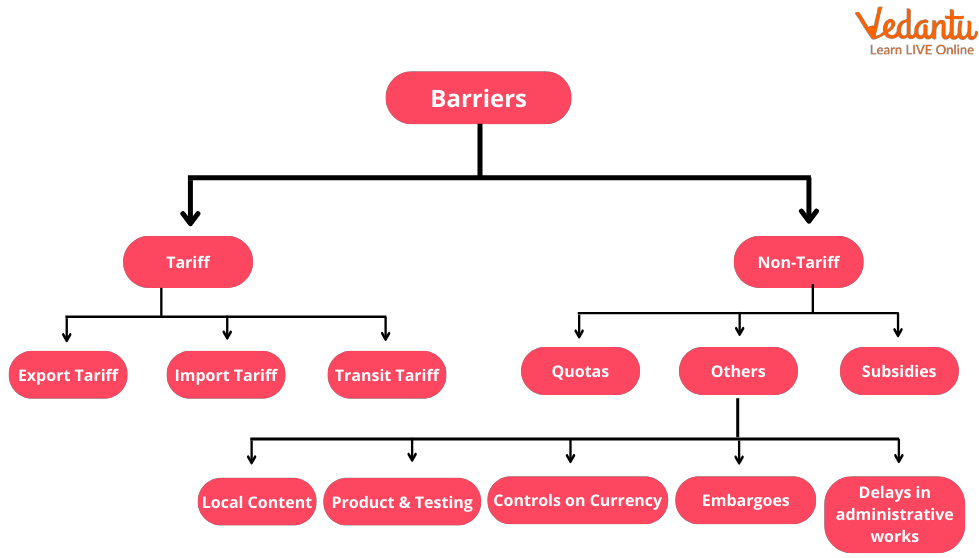




Trade Barrier: Introduction
The government imposes trade barriers so that their domestic trade can flourish without any foreign impact. Trade barriers are aimed at protecting domestic jobs. They help in improving trade deficits. They protect infant industries and protect against dumping. And sometimes they are imposed to earn more revenue.
Trade Barrier: Definition and its Types
Trade Barriers are defined as government-induced restrictions on international trade. They are imposed for various reasons, primarily to protect the domestic market and to earn revenue.
Types of Trade Barriers
There are six major types of trade barriers as discussed below.
Voluntary Export Restraints (VERs)
In this type of trade barrier, a nation limits the amount of export and increases the price of the goods and thus the revenue.
Regulatory Trade Barriers
The regulatory trade barriers are some legal barriers which hurdle the import of the products. These regulatory barriers are set by the government and specifically include product, safety, and pollution standards. For example, there are safety ratings for vehicles which need to be passed by the manufacturers to sell their products in the importing country.
Anti-Dumping Duty
Exporters, in order to earn more profit, sell their products below the actual cost in various countries. It is known as dumping. The government, in order to protect the domestic market from these dumped products, imposes the Antidumping Duty.
The Subsidy
Subsidies act as the support provided by the government to the firms manufacturing products to lower their production cost and become more competitive.
The Tariffs
Tariffs are taxes on imports. Tariffs are imposed to increase the price of imported products so that they are not consumed. There are many types of tariff, including ad valorem tax or a specific tax. A tariff diagram explains the effects of tariffs.
The Quota
Quota restricts the quantity of a product that can be imported into a country.
Tariff and Non-Tariff Barriers
A tariff Barrier is imposed by the government of the country importing goods. It has two-fold objectives, one to increase the government revenue and second, to raise the cost of foreign goods so that domestic companies can compete with the foreign goods. Examples of tariff barriers include Export duties, Specific duties, Import duties, Ad - valorem duties, Transit duties, Compound duties, Revenue tariffs, Protective tariffs, Counter - vailing and Antidumping duties, Single - column tariff, Double - column tariff.

Types of Barriers
Non-tariff barriers are defined as non-tax measures adopted by a nation's government to limit imports from foreign countries. These can be in the form of laws, policies, practices, conditions, requirements, etc. and are specified by the government to restrict imports. Examples of non-tariff barriers are Import quotas, Voluntary Export Restraints (VERs), Import licensing, Technical and administrative regulations, Price control, Foreign exchange regulations, Consular formalities, Quantity restrictions, and Pre-shipment inspection and Rules of origin.
Import Tariff and Its Benefits
An import tariff is particularly imposed on the price of imported goods. Import tariff benefits the country importing goods since it generates revenue for the government. Import tariff creates a friendly competitive environment for domestic companies.
Retaliatory Tariff
A country imposes a retaliatory tariff in order to pressurise another country to remove its tariffs or it may be imposed for the purpose of trade concessions.
Tariff v/s Non-Tariff Barriers
Tariff Barrier includes taxes or duties which the government imposes, whereas non - tariff barrier includes all the restrictions except taxes imposed by the government. Tariff barriers are explicit in nature, whereas non-tariff barriers are implicit. The tariff barrier leads to revenue generation for the government, whereas no revenue is received due to non-tariff barriers. A tariff barrier affects the price of imported products, whereas non - a tariff barrier affects the quantity, price, or both of the imported products.

Types of Non - Tariff Barriers
Summary
Tariff barriers make a nation self-sufficient and also reduce dependency on foreign goods. Non-tariff barriers act as hindrances to international trade, and these can be legal or bureaucratic. Reasons for imposing tariff and non-tariff barriers are multifold, including national security, retaliation, protection of domestic jobs, protection of startups, etc.






FAQs on Trade Barriers: Hurdles in International Trade Explained
1. What are the four most common types of trade barriers?
The four most common trade barriers are subsidies, anti-dumping duties, regulatory barriers and voluntary export restraints. Anti-dumping duties are levied when a nation dumps goods in the country. Regulatory barriers regulate the trade with certain specific guidelines. Voluntary export restraints are arrangements between the exporting and importing nations whereby the exporting country limits the number of specific exports on demand by the importing country.
2. What is the significance of trade barriers?
Trade barriers are imposed by a nation to protect its domestic markets from the influence of foreign goods. They protect a nation’s home economy and also generate revenue. Trade barriers typically reduce the number of goods imported. The significance of trade barriers can also be seen in India as our country has determined to become self-reliant and has reduced dependency on other nations. This has benefitted India in generating employment opportunities also and also enhanced its soft power the world over.
3. How does non - tariff barriers impact trade?
Non-tariff barriers reduce trade in two ways. Firstly, they increase the cost of doing business through product standards, customs procedures and various other means. Secondly, non-tariff barriers also restrict market access. Non-tariff barriers do not impose any kind of tax, therefore, they do not generate revenue for the government. Still, they do increase the regulatory procedures, which sometimes make the import and export of goods and services a long process.

































